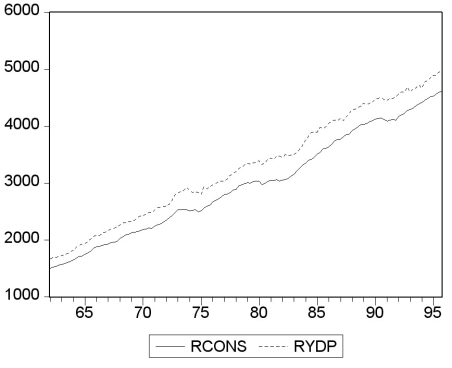Your textbook states that there "are three ways to decide if two variables can plausibly be modeled as cointegrated: use expert knowledge and economic theory, graph the series and see whether they appear to have a common stochastic trend, and perform statistical tests for cointegration. All three ways should be used in practice." Accordingly you set out to check whether (the log of)consumption and (the log of)personal disposable income are cointegrated. You collect data for the sample period 1962:I to 1995:IV and plot the two variables.  (a)Using the first two methods to examine the series for cointegration, what do you think the likely answer is?
(a)Using the first two methods to examine the series for cointegration, what do you think the likely answer is?
(b)You begin your numerical analysis by testing for a stochastic trend in the variables, using an Augmented Dickey-Fuller test. The t-statistic for the coefficient of interest is as follows: where LnYpd is (the log of)personal disposable income, and LnC is (the log of)real consumption. The estimated equation included an intercept for the two growth rates, and, in addition, a deterministic trend for the level variables. For each case make a decision about the stationarity of the variables based on the critical value of the Augmented Dickey-Fuller test statistic. Why do you think a trend was included for level variables?
(c)Using the first step of the EG-ADF procedure, you get the following result: t = -0.24 + 1.017 lnYpdt
Should you interpret this equation? Would you be impressed if you were told that the regression R2 was 0.998 and that the t-statistic for the slope was 266.06? Why or why not?
(d)The Dickey-Fuller test for the residuals for the cointegrating regressions results in a t-statistic of
(-3.64). State the null and alternative hypothesis and make a decision based on the result.
(e)You want to investigate if the slope of the cointegrating vector is one. To do so, you use the DOLS estimator and HAC standard errors. The slope coefficient is 1.024 with a standard error of 0.009. Can you reject the null hypothesis that the slope equals one?
Correct Answer:
Verified
View Answer
Unlock this answer now
Get Access to more Verified Answers free of charge
Q40: What role does the concept of cointegration
Q41: In this case, the Granger causality
Q42: Consider the following model Yt =
Q43: For the United States, there is somewhat
Q44: You have re-estimated the two variable VAR
Q45: There has been much talk recently
Q46: You have collected quarterly data for
Q47: Economic theory suggests that the law
Q48: Your textbook so far considered variables for
Q50: You have collected time series for various
Unlock this Answer For Free Now!
View this answer and more for free by performing one of the following actions

Scan the QR code to install the App and get 2 free unlocks

Unlock quizzes for free by uploading documents